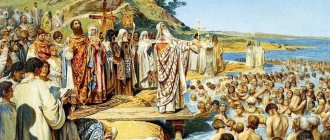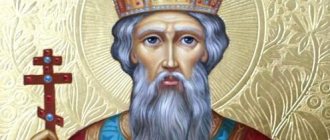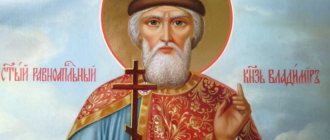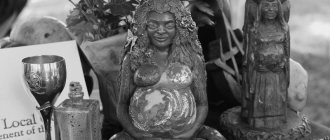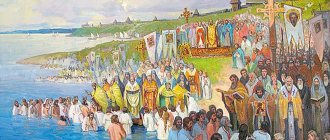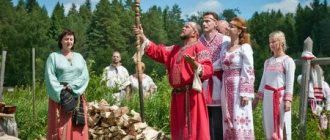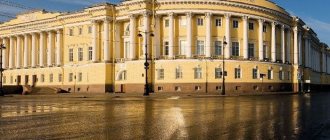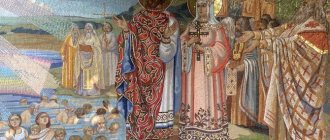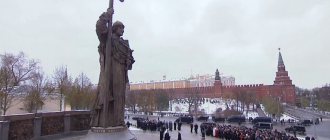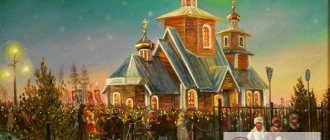Book | Video | About the project | Contacts | Sitemap | Forum | Blog | Construction | Eng
Home > Society > Modern Paganism
With the collapse of the Soviet Union, the term “paganism” began to gain more and more popularity among us. The biggest leap in popularity has been the last 5-8 years, years of rapid development of Internet technologies and Internet resources. Many people appeared who began to call themselves pagans. Modern paganism has become a subculture, and being a pagan has become sort of fashionable.
A huge number of communities dedicated to paganism have appeared on various social networks, and groups of related topics (for example, esoteric groups) have begun to pay more and more attention to this. People's interest has increased and continues to grow. To a greater extent, paganism attracts people with patriotic feelings, those who love their land, country, and Motherland. However, why are these people not interested in Orthodoxy, traditional for our region? Not all patriots are fascinated by paganism, but many are.
After the ban on religiosity was lifted, people had the opportunity to believe in anything or not believe at all. Some discovered Orthodoxy, others discovered other religious denominations and cults, but many decided to search for pre-Christian beliefs. It’s all because they have no respect for Orthodoxy, and the latter has lost all authority in their eyes. That is why anti-clerical sentiments are so strong among the people, and they treat Orthodoxy as some kind of Jewish project, specially created to enslave the Slavs and other peoples. This is the official position of modern paganism.
When I was at school, at some point I began to be interested in something metaphysical, well, it’s understandable: sooner or later a person asks himself such questions. On the bookshelf at home, I found a book dedicated to astrology, various zodiac signs, their descriptions, and so on. The inclination of my mind and predisposition towards “humanities” aroused my great interest in this entertaining reading. I began to study descriptions of various zodiac signs, memorized them in order to be able to obtain information about this or that person, to know what could be expected from him and what his character was, to select friends according to this principle or, conversely, to avoid someone.
I seriously believed in astrology and believed that these descriptions were actually true, and with their help I could find out something about a person just by his date of birth. My head was full of this nonsense for a long time, but after a lot of experience in studying people according to this principle empirically, I came to the conclusion that these descriptions are incorrect and that each of them can be true for any of the 12 zodiac signs. So I lost faith in astrology, and not because someone told me, but because I myself understood this pseudoscientific teaching.
I was also terribly superstitious and seriously believed that omens worked: if you do this and that, then you will be successful in such and such - and it seemed to me that it worked! I believed that if I carried out a certain ritual (for example, not saying hello across the threshold, looking in the mirror before leaving, sitting down “on the path”, etc.), then success would definitely await me or at least there would be no disappointments today and unpleasant situations. Because unpleasant situations could greatly disappoint me and cause stress, which I really didn’t want, like most normal people. And therefore, due to my mental weakness, I resorted to such dubious methods of dealing with them. I believed in pagan astrology and had pagan forms of belief - superstition . I was a real pagan!
“What did old men or old women come up with from time immemorial? They decided that the child should not be carried out until six weeks old, nor shown to a stranger, otherwise he would immediately be jinxed. This means, in other words: give the newborn peace, do not unwrap, do not open, do not disturb or drag him around the rooms, but cover him lightly, completely, and with his head. Here’s another similar case: don’t praise a child - jinx it.” V. I. Dal. “On beliefs, superstitions and prejudices of the Russian people.”
As I grew older, becoming interested in various natural sciences, as well as studying religions, I realized that that model of belief and attempt to explain certain things (predict them, influence them) is primitive, childish, underdeveloped. This is the simplest attempt to explain something metaphysical, transcendental.
I was a pagan, but I was not a follower of the modern pagan subculture “Rodnoverie”, which is now so popular. I wasn’t for one simple reason: I didn’t know anything about it and I had no place to get such information from, although Rodnoverie already existed. If I grew up in the modern period, with all these gadgets, social networks and such a saturated Internet, then I might have become interested in this phenomenon. However, my views evolved earlier, long before my acquaintance with Rodnoverie and modern paganism.
Those. being at that stage of development of my views, I was greedy for various unknown, esoteric things. I was attracted to this mysterious and unknown. What if I can learn something from smart books and learn to do something that I didn’t know how to do? A completely reasonable and healthy desire. Paganism is very attractive because it offers easy ways to solve problems, but in practice these ways turn out to be incorrect and dead ends. At a young age, a person wants everything, immediately and quickly, which is why pagan elements are so attractive to young people fascinated by them.
Why do many people become interested in paganism in adulthood? It is obvious that they are at an early stage in the development of their views and have only just come to this conclusion. I was lucky and became interested in it at school, but many people are not so lucky and come to it later, often in adulthood. A huge part of them also eventually evolve and cease to be superstitious, cease to believe in astrology, horoscopes, healers and sorcerers, in damage and the evil eye, in love spells and lapels, in various voodoo cults, black cats, tarot cards and other palm readings. However, many continue to adhere to their beliefs, stubbornly refusing to acknowledge objective criticism of neo-paganism.
In Russia, not Christian religions, not always polytheistic ones, are called paganism
“Paganism” is a word that is used in many different ways. Two people discussing paganism may not even understand that each had something different in mind. Therefore, this term should be used carefully. Most often it means the following:
Polytheistic religions. The most striking example is the religion of ancient Greece. Today these beliefs are few and far between and in an updated form. The question of the possibility of monotheism in ancient religion is debatable. If such a thing existed, its features were absorbed into later forms of Greek polytheism.
The Blue Stone (Pereslavl-Zalessky) is an object of veneration by ancient pagans; to this day people believe that touching it cures diseases
For a Christian, the idea of many gods is alien, although the concept of “gods” appears from time to time in the Holy Scriptures.
“Has any people changed their gods, although they are not gods? but My people have exchanged their glory for something that does not help.”
(Jer. 2:11)
Be that as it may, even if we make allowances for their existence, the worship of such gods is contrary to Orthodox doctrine. Christians represent the Lord God as a much higher, powerful being and the only one worthy of veneration.
Externally polytheistic religions. Some religions have signs of polytheism, but preach monotheism in their theology. A striking example is the religion of ancient Egypt. For the Egyptians, various deities (Ra, Osiris, Anubis, Bast, Isis) were just different manifestations of one supreme God. Polytheism here is only external. He misleads many. Similarly, an ancient Egyptian, having found himself in a modern Orthodox church, would have considered the saints to be different deities of Christians.
Another example of such a religion is Hinduism.
Christians can call any non-Abrahamic religion paganism.
Christians call these religions pagan for various reasons:
- They do not understand complex theology;
- They rely on various goals of the spiritual life of believers;
- They point to the absence of Christian dogmas in outwardly polytheistic religions.
Not Abrahamic religions . Zoroastrianism is a monotheistic tradition, but it is not based on the Old Testament. Accordingly, there are fewer points of contact with Christianity than with Judaism and Islam.
There is no consensus among Christian theologians about whether it is permissible to say that the Zoroastrian Ahura Mazda and God the Father are one and the same person. This gives grounds for a number of Christians to call Zoroastrianism a pagan religion.
Judaism and Islam . The most radically thinking of Christians believe that even a general veneration of the Old Testament and faith in the One God is not enough to call something other than Christianity a non-pagan faith.
This is not a popular opinion among Christians, but it exists.
Occultism . Occultism itself does not always imply some kind of religious teaching. But not all Christians go deep into the matter. Therefore, the word “paganism” is often loosely applied even to witchcraft or astrology.
Buryat shaman. From a Christian point of view, he ideally fits the definition of “pagan” because he professes shamanism. Photo: 2.bp.blogspot.com
Replacing idols with crosses
Paganism ceased to exist de jure after Prince Vladimir adopted Christianity in 988. De facto, it coexisted with the Orthodox faith on the territory of Rus' for a long time. Paganism was perfect for tribal existence, when one tribe worshiped its own god, and another - some other god with its own habits. Paganism fueled possible confrontations and struggles for territories. What can we talk about when, even in the 21st century, many wars begin on the basis of determining the “correctness” of a particular belief.
But still, monotheism (belief in one God) is more suitable for a united state, since beliefs are easier to control, and in this case there can be no division, it would seem (remember Catholics, Protestants, Orthodox, etc.). If in Orthodoxy one god created everything and controls everything, then in paganism the gods were responsible only for certain spheres of people’s lives or natural phenomena. A simple comparison with ants: for a colony of ants, children flooding them with water are pagan gods, and monotheism is the ants' one god (I'm not sure what religion they belong to) or Darwin's theory of evolution.
Slavic paganism existed, but little is known about it now
Slavic paganism is a belief that was widespread among our ancestors even before the baptism of Rus'. We can say that this is the original, traditional religion for our people.
No one knows what she was like anymore. During the process of Christianization, the traditional religion was subjected to serious persecution, so that the Slavic pagans were forced to remain in the shadows, and their numbers were significantly reduced.
The main problem for historians of religion is the lack of writing among the ancient Slavs. Because of this, we do not have a single reliable historical source that could tell us anything about the beliefs of our ancestors.
Only Christian authors tell us about the pagan tradition of the Slavs, but this is scant information and, of course, distorted for ideological reasons.
Stribog
0
Another god from the Vladimir pantheon is Stribog. He is usually considered the god of the winds, but in the “Tale of Igor’s Campaign” we read: “Behold the winds, Stribozh’s grandchildren, blow arrows from the sea onto Igor’s brave regiments.” This allows us to talk about Stribog as the god of war. The first part of the name of this deity “stri” comes from the ancient “street” - to destroy. Hence Stribog is the destroyer of good, the destroying god, or the god of war. Thus, Stribog is a destructive principle as opposed to the good Dazhdbog. Another name for Stribog among the Slavs is Pozvizd.
The religion of the ancient Slavs was partially preserved in traditions and even Orthodoxy
What kind of faith did we have initially? What did our ancestors fight for when resisting Christianization? Today we call this religion Slavic paganism. No one knows what it was called before.
We also know little about religion itself. Mostly these are names.
Zbruch idol made of stone, approximately X. It gives some idea of how the ancient Slavs imagined deities. Photo: img.lookmytrips.com
Almost no historical documents have survived. The first Russian Christians tried to destroy the previous religion, and if they mentioned anything about it somewhere, it was mostly cursory and in a negative context.
And yet we know something:
- It was a developed, thoughtful religious tradition;
- Names of some gods: Single sources give us the names of some gods Perun, Chernobog, Svarog, Dazhbog, Makosh, etc.;
- There was a cult of ancestors and complex ideas about the afterlife;
- Our ancestors valued this faith very much and went to their death for it.
Pagan beliefs were very dear to the Slavs, they even died for them.
We can only guess at what stage this religion was:
- Monotheistic . Then all gods are personifications of the powers of a single deity.
- Polytheistic . This would mean that religion was gradually degrading.
- Belief in spirits . Which is quite likely, given that we still have ideas about the spirits of rivers and forests. However, it is possible that today they are small spirits, but before they were revered as gods or manifestations of the one God.
A number of traces of the former religion, as always happens, penetrated into Orthodoxy:
- The willow on Palm Sunday is a memory of the ancient holiday of Verbokhleste.
- The commemoration of the dead after Easter also replaced a similar pagan holiday.
- Paraskeva Pyatnitsa is a Slavic goddess who has taken root in Orthodoxy.
What do paganism and Christianity have in common and how do they differ?
Where did the pagan Slavs go after death?
At the heart of any religion, one of the most important questions is related to where a person, soul or something else goes after death. In Christianity, this is hell and heaven: in one place there are conventional rivers of milk and jelly banks, and in another - very specific devils are boiling you in a cauldron. The Slavs had their own opinion on this matter; they divided the world into three parts: reality, rule and nav. Reality is the world of real and visible things, and Prav and Nav are peculiar two opposites of the afterlife. The soul of a person falls into the right (only here the soul was called not the abstract essence inside a person, but his very personality), who lived “according to his conscience,” and the nav includes the restless souls or those who committed atrocities. There was no punishment for this, it just happened that way.
Instead of temples and churches, the pagans had temples - open sanctuaries on which idols of deities were installed. Most often, idols were made in the form of wooden or stone pillars. A fire was usually located there as one of the main attributes - and sometimes altars. Rituals were also performed during festivals or to increase fertility in fields, hills and other open areas. It was assumed that this would make it easier for the gods to see events in their honor.
And the ancient clergy - the Magi - monitored the correct observance of rituals and ceremonies. These were revered people who performed rituals, sacrifices, “communicated” with the gods, conjured the elements and made prophecies. They didn’t just perform “dances with tambourines,” but practiced healing and mastered the basics of astronomy. You can call them generalists; in their specificity, they were closer to scientists, although at that time they were engaged in many things that were far from modern science.
Vedic kinship is not a revival of paganism, but neo-paganism
One of the most famous pagan traditions in our country is Rodnoverie. Adherents of this religion like to claim that they are modern pagans in Russia. If for a Christian the word “pagan” carries a negative connotation, then for Rodnovers it is a source of pride, because it is a way to emphasize their connection with their ancestors.
One of the main missions that the Rodnoverie undertakes is the revival of paganism in Russia. But in reality there is no talk of any revival. To revive something, you need to understand what we are talking about. We do not have any evidence or detailed descriptions of the essence of the native faith of the Slavs. The Rodnovers are not engaged in restoration, but in falsification of the Slavic religion.
“The Book of Veles” is a fake, on which many of the teachings of the Rodnovers are based. Photo: s5-goods.ozstatic.by
A striking example is the “Book of Veles” and the “Slavic Aryan Vedas,” fabricated sources that neither religious scholars, nor archaeologists, nor historians take seriously.
Here is an example of text from the “Veles Book”:
“Veles taught our forefathers to plow the land, and sow grain, and reap straw in the suffering fields, and put a sheaf in the dwelling, and honor Him as the Father of God. Glory to our fathers and mothers! Because they taught us to honor our gods and led us by the hand to the right path. So we walked, and were not parasites, but were Russian Slavs who sing glory to the gods and therefore are Slavs.”
A lot of historical and linguistic errors in these books indicate a very late, almost contemporary, date of writing.
But few native believers want to listen to these arguments. From the instilled point of view, his religion is the Vedic Rodnoverie, that is, a tradition that is based on a centuries-old oral tradition, the Vedas. The only catch is that only the Indo-Aryans had the Vedas. But the existence of any Slavic Vedic knowledge will not be confirmed by any specialist familiar with the issue.
Dazhdbog
0
There is no dispute regarding the solar nature of Dazhdbog. His name comes from “dazhd” - to give, that is, God willing, giving God, literally: giving life. According to ancient Russian monuments, the sun and Dazhdbog are synonyms. The Ipatiev Chronicle calls Dazhdbog the sun in 1114: “The sun is the king, the son of Svarog, aka Dazhdbog.” In the already mentioned “Tale of Igor’s Campaign” the Russian people are called Dazhdbozh’s grandchildren
Rodnovers are not prohibited, although sometimes they have problems with government officials
Sometimes people who are far from the topic loudly declare that Rodnovers are prohibited. Nonsense. You can only ban a specific organization, but the law does not allow you to ban some abstract categories such as Christianity, Satanism or Rodnoverie.
A ban requires grounds. The “Corner Article for Sectarianism” is the speculation of people who are incompetent and ignorant in legal and religious matters. There is more noise than necessary. There are no sects hostile to Christianity and society, just as there are no sectologists in the register of professions. There is only the concept of an organization whose activities are criminal, or whose ideology calls for criminal activities: murder, violence, theft, etc.
“Criminal article for sectarianism” is a fiction, it doesn’t happen
Some spiritual leaders of the Rodnoverie have had problems with government officials, but this cannot cast a shadow on the tradition, just as criminal priests are not able to discredit Christian teaching.
But there are still a couple of points that negatively affect the reputation of Rodnovers:
- Sermon on the peculiarities of the Slavic race . The very concept of being chosen on racial and religious grounds is a reason for pride, which is unacceptable for a spiritual tradition. However, many Rodnover leaders speculate on this topic, calling the Slavs a superior race. This theme is cross-cutting for a number of Rodnoverie traditions, although there are those who speak out with restraint: the races are different, none is better, each has its own mission.
But this is still fertile ground for racial intolerance, which is why some media outlets accuse the Rodnovers of Nazism. Coupled with the recently intensified propaganda of false patriotism, this creates a truly dangerous mixture.
- Managing a person's personal life . A number of Rodnoverie communities make rather strict demands on their adherents: leaving for villages, large families, refusal to communicate with people of other faiths. This approach cuts people off from the world and makes a person hostage to the communal system. Leaving without connections in the outside world, but with 10 children in your arms, is really difficult.
However, such situations are quite rare. Most Rodnoverie traditions do not try to control a person’s life to such an extent, but are limited to rituals, worldview and moral principles.
Basic rituals
- Wedding. The customs of dressing the bride for a wedding, the comic abduction of the newlywed and the ransom - all this refers to pagan wedding rituals. The bride's mother baked a special pie - kurnik, which was taken to the groom's house. And the future husband brought a rooster to the bride’s house. The wedding took place near the oldest oak tree in the area;
- Tonsured. All children who reached the age of 7 went through this ritual. After the ritual, the child was believed to pass from the care of the mother to the father;
- Rituals during the construction of a new house were carried out in order to protect the building and its future inhabitants from the machinations of numerous evil spirits.
Rodnoverie and Orthodoxy treat each other coldly
The dispute about the traditional faith for Russian people is a stumbling block for Orthodox and Rodnovers.
Rodnovers reproach Orthodoxy for the forced baptism of Rus', the betrayal of the religion of their ancestors, and the destruction of tradition. And historical sources here are really on the side of the Rodnovers.
The Orthodox note that the Rodnovers are a collection of neo-pagan religions that do not have the right to hide behind tradition and are in no way connected with the lost religion of the Slavs. Orthodoxy also notes that the ancient faith was the religion of the Slavs, but Orthodoxy is the religion of a new state, Russia, which from its very inception did not know any other faith.
Rodnovers prefer to wear clothes similar to those worn by the ancient Slavs. Photo: rodnovery.ru
What adds particular drama to this confrontation is that some pagans claim that Rodnoverie and Orthodoxy are the names of their traditions, synonyms. Allegedly, “Orthodoxy” means “to glorify the Rule,” and Christians have illegally appropriated this word for themselves.
Orthodox priests also speak rather harshly about the Rodnovers, unjustifiably indiscriminately accusing them of extremism. For example, here is a statement by Archpriest Dimitry (Vasilenkov):
“Neo-paganism is not a return to the roots, although there is a certain group that tries to study ancient beliefs. Unfortunately, this is the flag that modern extremist youth groups are now raising.”
But still, you shouldn’t go to extremes and generalize. There are dark spots on the face of every religious tradition. Moreover, it is worth considering that the percentage of Rodnovers among believers is negligible, and therefore they have never posed, do not pose, and are not going to pose any threat.
Today, it is the Rodnovers who for the most part suffer from the pressure of the Russian Orthodox Church, and the Christians themselves do not notice the pagans neighboring them.
Hierarchy of pagan gods
- The ancient Slavs believed in the main God - the ancestor and ruler of the other deities. This God, as mentioned above, was Perun. He knew how to create lightning and ruled the world.
- Other deities depended on the main God and were considered intermediaries between him and the world of people.
- Next came the forces of nature , by which people could predict their future. It was believed that every forest, river, field has its own spirit that controls this particular element.
Rodnovers are not the only pagans
In addition to the Rodnovers, there are many more pagan traditions in Russia. This is not surprising, because we have a multinational country. First of all, these are various shamanistic traditions of the eastern regions.
There are also those who were attracted by some foreign religion, usually a restored one (neo-Hinduism, Kemetism, etc.).
But the number of such believers is very small, and therefore they are completely invisible in the public religious life of our country.
By leaving a comment, you accept the user agreement
